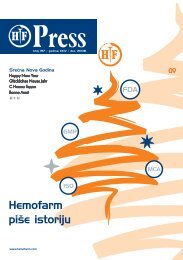NEW HEMOFARM PREPARATIONS TO APPEAR SOON
NEW HEMOFARM PREPARATIONS TO APPEAR SOON
NEW HEMOFARM PREPARATIONS TO APPEAR SOON
Create successful ePaper yourself
Turn your PDF publications into a flip-book with our unique Google optimized e-Paper software.
A LOW COST METHOD OF DETECTION OF UTERINE CERVIX CANCER<br />
Scientists have found in London that there are much cheaper ways than the pap smear test and colposcopy for the<br />
detection of uterine cervix cancer.<br />
Namely, the uterine cervix cancer, as is asserted in these studies, can also be detected with the aid of acetic acid, cotton<br />
gauze and a strong light. This method, as they claim, can save millions of women who can afford modern examinations.<br />
This study, which was published in The Lancet Medical Journal, shows a simple visual screening test, with the aid of which it<br />
is possible to determine the early signs of uterine cervix cancer, which can help reduce the total number of cases of this<br />
disease by a quarter.<br />
This study is a turning point in the prevention of uterine cervix cancer – said Dr. Harshad Sanghvi, the medical director of<br />
JHPIEGO, an international health organization which deals with the prevention of the uterine cervix cancer in the poorer<br />
countries, following the publishing of the study.<br />
Anyway uterine cervix cancer can really be prevented if the first signs are detected early. At least 250,000 women die of<br />
this disease per year and more than 80% of the diseased come from the developing countries.<br />
This visual screeing test can be done by nurse or a person trained to give healthcare assistance and this is done by firstly<br />
washing the cervix with the aid of gauze and acetic acid, using a speculom to keep the cervix open. Following one minute<br />
in case of precancerous lesions they become very white and can be seen by naked eyes with the help of a halogene<br />
lamp. Researchers from France have used this method with the assistance of their colleagues from India as a screening test<br />
in the case of 49,311 women in the period from 2000 to 2003. When they saw lesions, they eliminated them straight<br />
away. Other 30,958 women were sent for detection of the first signs and symptoms of uterine cervix cancer as well as for<br />
regular visits to institutions where screening was made possible for them. These women were followed in the period from<br />
2000 to 2006.<br />
167 cases of uterine cervix cancer were noted among them, as well as 83 deaths from this disease. There were 92 death<br />
cases among those who did not follow-up their condition and have the screening. This shows that there were 35 percent<br />
fewer deaths among women who had screening as compared to those who did not. Also, there were 25 percent fewer<br />
cases of cancer among them.<br />
All the women in the study were healthy and were aged between 30 and 59, when the study began.<br />
This screening, as the scientists say, proved to be as efficient as the pap smear test, which is a much more expensive<br />
technique which is applied in the West and entails taking cells from the cervix so as to be studied under a microscope in a<br />
laboratory.<br />
It is possible to drastically reduce the rate of diseased from uterine cervix cancer by this ‘’new’’ test – pointed out Sanghvi.<br />
Experts believe that this low cost method can also be applied in modern countries, just as it is applied in the developing<br />
ones.<br />
This study has given us guidelines as to how we can detect at low cost the first changes on the cervix, yet this method is not<br />
perfect. There are many mistakes and possibilities for changes not to be cancerous and therefore the medical workers<br />
would have to be well trained in this field. Also, this test could not be applied in the case of menopause women, nor in the<br />
case of those who have had more than two, three children, because in their cases the changes on the cervix occur in those<br />
zones which are not visible to the naked eye – said Dr. David Kerr, professor of Clinical Pharmacology at Oxford.<br />
Still, he admitted, the pap smear test is really expensive for women from poorer countries.<br />
DARK CHOCOLATE REDUCES BLOOD PRESSURE<br />
Following serious studies, scientists have determined in Germany that cooking chocolate reduces blood pressure, but the<br />
quantity required for this effect to be achieved is less than one chocolate cube. The health benefit of dark chocolate has






